California Name Change: A Complete Guide

Legally changing your name in California is not for the faint of heart. Not because it's hard, but because the plentiful choices may catch you off guard without smart planning.
However you're changing your name, you must learn how much it'll cost; when, where, and how to begin; documents, IDs, options, and bringing everything to conclusion.
Legal name change starts with getting proof of your changed name. The next step is to notify government agencies, such as the Social Security Administration and CA DMV.
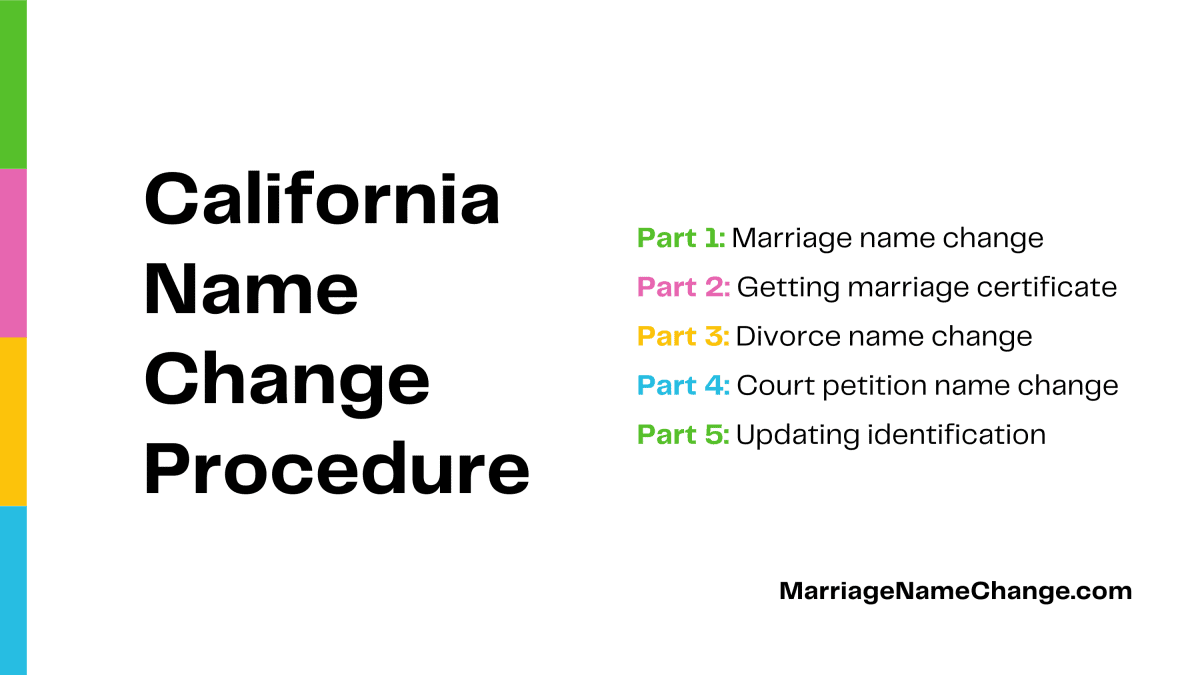
We'll show you how to complete the name change process without a lawyer, whether done through marriage, divorce, or court petition.
Marriage name change in California
The number of ways you can legally change your name after marriage in California is stunning. And well worth considering in depth before your wedding day.
California's explicit options for changing your middle and last name are arguably the most extensive and generous in the nation.
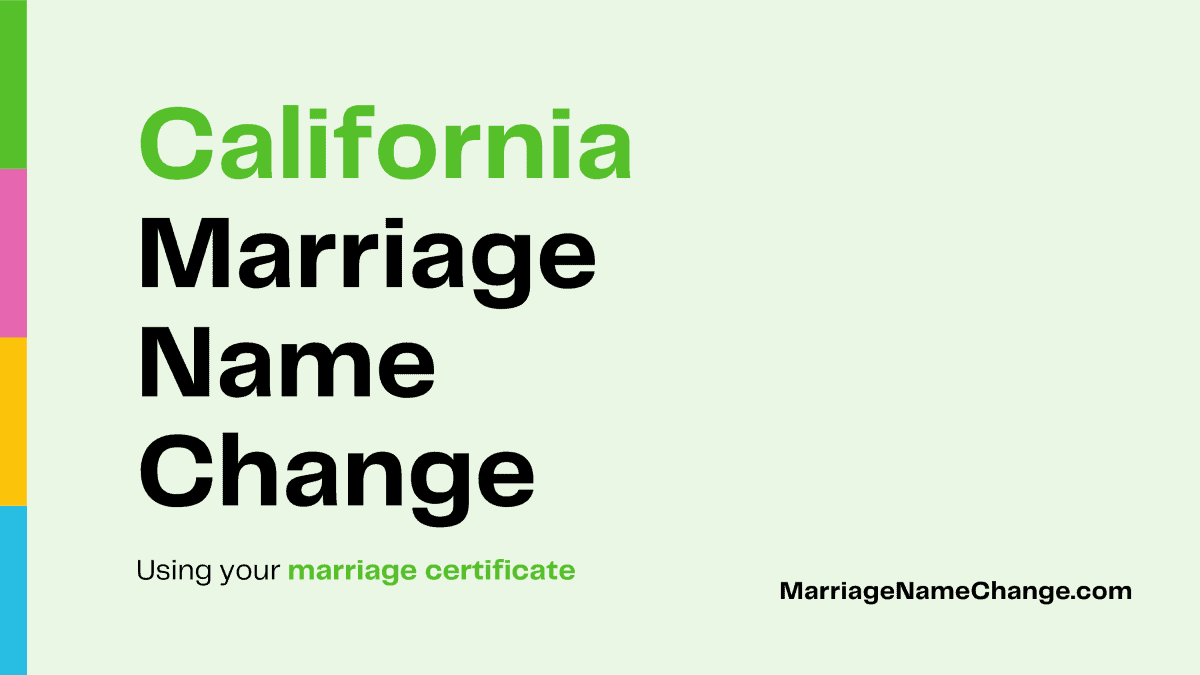
Your marriage certificate is the linchpin, serving as proof of your new married name. It will allow you to change both your middle and last name after marriage.
You can save time and start the name change process before or after you're married. Be ready to download, print, and mail your auto-filled PDF name change forms.
California's Name Equality Act
The Name Equality Act of 2007 (PDF, 310 KB) governs California's marriage name change laws. It went into effect for marriage licenses issued on and after January 1, 2009.
Changing your last name
California law allows every party to a marriage—husband and wife—to change their names by designating it on the marriage license application. There are four grand options:
1. Take your spouse's last name
You can take your spouse's current last name as your new last name, following the traditional approach, while still using your maiden name in other contexts.
2. Take your spouse's last name at birth
You can adopt your spouse's maiden name as your own name, skipping their current surname outright. This doesn't apply to their other last names between birth and right now.
3. Return to your maiden name or last name at birth
You can change your last name back to your maiden name (if different), forgoing your spouse's surname. This shows the elasticity of California's name change laws.
4. Hyphenate, space-separate, or combine your last names
You can create any combination of you and your spouse's current last names or birth names. Separating them with a hyphen (-), space ( ), or nothing (making them flush).
You can join your names in either order when hyphenating or combining.

For instance, you can hyphenate your last name with your spouse's name, their birth name, or your maiden name. Yes, you can exclude your partner and self-hyphenate.

Using a space to separate your names is called a double-barreled name change. It's becoming more popular. Caution, people may confuse the first part as your middle name.
For example, imagine your name histories were:
- Your surname: Alpha
- Your birth surname: Delta
- Your spouse's surname: Omega
- Your spouse's birth surname: Sigma
You could rename to Alpha-Delta, Alpha-Omega, Alpha-Sigma, Delta-Omega, Delta-Sigma, or Omega-Sigma. You can replace the hyphen with a space or no symbol.
This meeting in the middle happy compromise works well when you want to take your spouse's name and support your identity for family, legal, or business reasons.
5. Create a brand new last name by blending surnames
You may create a brand new hybrid last name by carving out one segment of your current or birth name with a slice of your spouse's current or birth name.
This is identical to the prior combination name change we just covered, except your newfound name must be a single word—no additional hyphens or spaces allowed.
For example, let's assume your name histories were:
- Your surname: Bravo
- Your birth surname: India
- Your spouse's surname: Oscar
- Your spouse's birth surname: Tango
Example blends could be Bravondia, Bravoscar, Bravango, Indisca, Oscarango, etc.

The permutations are vast. You can extract any part of your names—beginning, middle, or end. One letter or multiple. But you're only allowed to clip one segment per name.

You're only limited by your imagination when picking a segmented name. Just don't forget to decide before getting married. Your choice must appear on your marriage license.
Even if your marriage records indicate that you intend to change your name after marriage, you don't have to actually do it. It just keeps your options open.
Changing your middle name
You can either change both your middle and last names at the same time, or just alter one. You've got three noteworthy choices:
1. Replace with either's last name
You can replace your middle name with you or your spouse's current last name.
2. Replace with either's last name at birth
Replacing your middle name with your maiden name is a popular, well-supported choice. Your prospects extend to both you and your spouse's birth names.
3. Combine with either's current or last name at birth
You can hyphenate your middle name with either your own or your spouse's current last name or birth name, use a space instead of a hyphen, or join them without a separator.
Unsupported name changes
You can't change your first name by getting married; you'll have to petition the superior court for that. This aligns with the law in other states too—no workarounds or loopholes.
You also can't drop your middle name, replace it with an initial, or create a blended variation (like you could for surname changes). That too demands a court decree.
Getting a California marriage certificate
You can change your name in California using a certified copy of your marriage certificate, but you must apply for a marriage license to get that certificate. Here's how…

1. Where to apply and fees
You can apply for a marriage license at any California county clerk's office. It costs between $35 and $110, with a statewide median of $75. (The fee varies across counties.)
The license fee does not include a certified copy of your marriage certificate, which you'll use to change your name. The certificate costs $15 to $17 extra per copy.
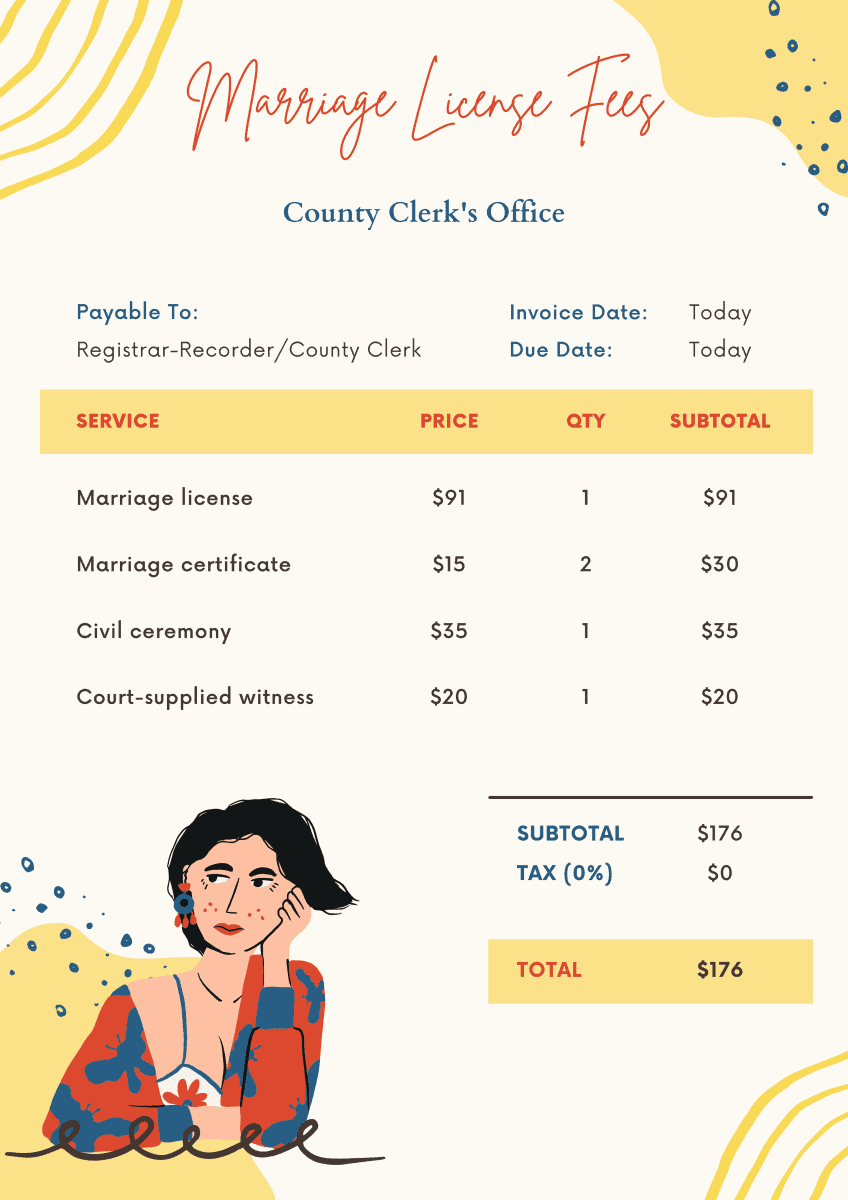
You may apply for and marry by proxy if you're a member of the U.S. Armed Forces stationed overseas in a conflict. Just provide your substitute power of attorney (PDF, 109 KB).
You'll get your license right away—no waiting period. You can then get married any time. It will expire 90 days after issuance, so plan well.
Your California marriage license is valid for use statewide, but can't be used out of state. Similarly, you can't se another state's marriage license in California.
2. The application
The marriage application will ask you for your:
- Current name
- Last name at birth
- New last name after marriage
- New middle name after marriage
- Birth date and place of birth
- Address
- Phone number
- Parents' birth names and birth places
- Marital status (total, when and how last ended)
You must choose your new name on the marriage license application, or you'll lose the right to change it through marriage. You can't amend it after you marry.
3. Choosing a license type
California offers two types of marriage licenses:
- Public license:
- Is a public record.
- Is sold only by county clerks.
- Anyone can purchase certified copies.
- One to two ceremony witnesses are required.
- Confidential license:
- Is not a public record.
- Is somewhat more expensive.
- Is only sold to adults age 18 and older.
- Is sold by county clerks and approved notaries.
- Only the married couple can purchase certified copies.
- Must sign affidavit stating that you live together.
- Ceremony witnesses are not required.
A confidential license makes sense if you want to keep your marriage a secret.

Contact your county clerk's office to find a notary public authorized to issue confidential marriage licenses. The county clerk's office maintains a pre-approved list of notaries.
4. Age requirements
Minors 17 years old and younger may marry with the written consent of one parent or guardian and a court order. Emancipated and pregnant minors aren't exempt.
The consenting parent needn't have custody. If no parent is available or willing to grant consent, the family court will make the decision on its own.
Minors must get their court order 30 days before applying to get married. Pregnant 16- and 17-year-olds are exempt from this waiting period.
5. Identification and other documents
Bring photo ID that shows your birthdate, and issue and expiration date, such as a:
- Driver's license
- Passport
- State ID card
- Military ID card
- Permanent resident card
The clerk might ask for other documents, such as your:
- Birth certificate (minors and adults)
- Dissolution or divorce decree (if applicable)
You don't have to present your:
- Social security card
- Social security number (SSN)
- Prior spouse's death certificate (if any)
The "usage method" of name change
California common law allows you to change your name through the "usage method" just by using your new name every day—no paperwork or courts. It doesn't apply if you're:
- A minor
- In prison
- On probation, or
- A convicted sex offender
Usage is good in theory but impractical. You can’t use it to change your name on government-issued IDs or bank accounts. It’s wiser to opt for an actual, legal name change.
Divorce name change in California
Use a certified copy of your divorce decree to change your name after divorcing. Ask the judge to insert an order that restores your maiden name or any former name.
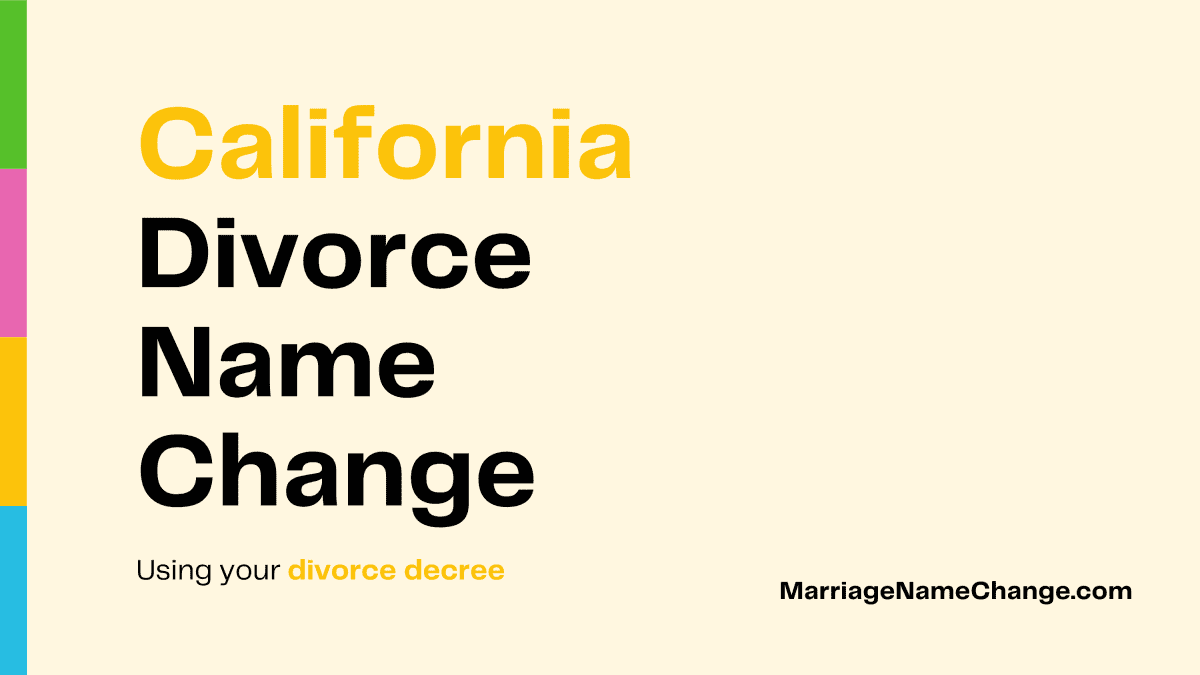
Didn't ask for your old name back?
You can retroactively amend your divorce judgment by filing an Ex Parte Restoration of Former Name (FL-395, PDF, 52 KB) with the California court clerk where your divorce took place.
Contact the clerk with your divorce case number. They'll tell you where to send the form and whether you need to include a self-addressed, stamped return envelope.
Petition the court for a name change in California
Changing your legal name through California's courts is three things:
- Expensive
- Time-consuming
- Heavy on paperwork
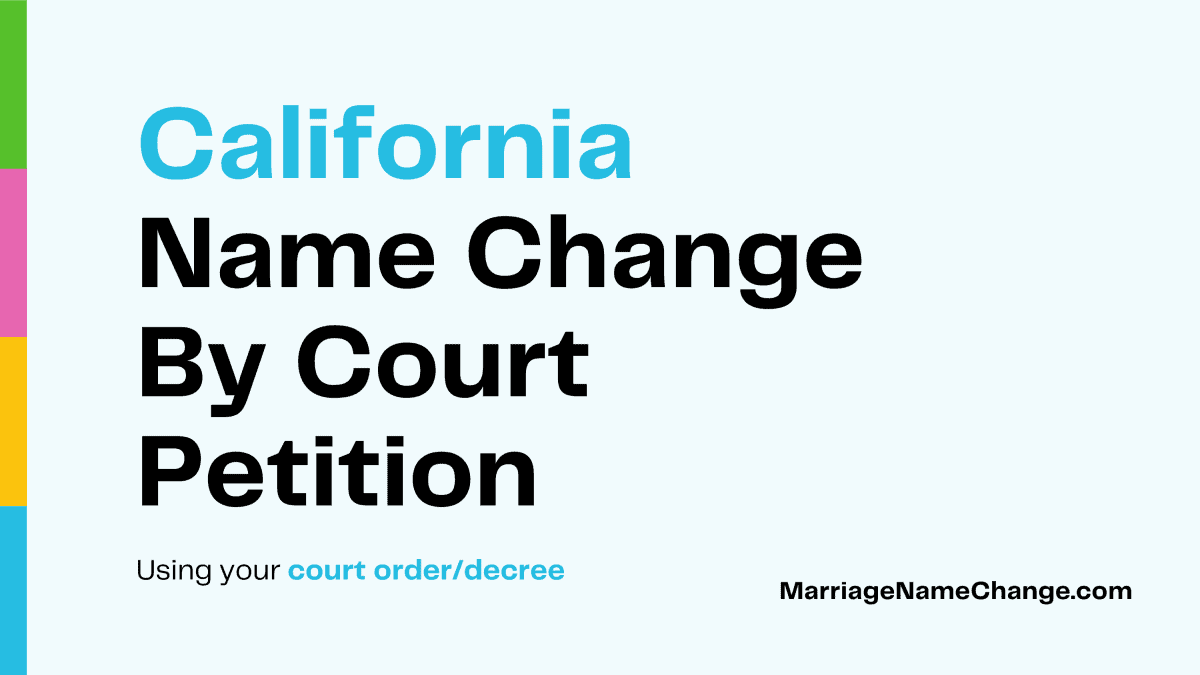
Let's detangle the steps into simple bite-sized chunks, whether you're changing your own name or a parent or guardian changing your child's name.
Visit the superior court
File your petition for a change of name at the California Superior Court in your county of residence. If petitioning on behalf of someone else, go to court in their county.
Filing fee and court fee waiver
It costs between $435 and $450 to file a petition for a change of name in California. You can lodge a request to waive court fees if you can't afford them because you're:
- Low income
- Getting public benefits, or
- Unable to pay court fees and household needs
You're assured a waiver if you're on food stamps, CalFresh, SNAP, Medi-Cal, CalWORKs, CAPI, IHSS, SSI, SSP, General Relief, General Assitance, or Tribal TANF.
Other waiver applicants must document their household income. The least eligible must go further—reporting assets, property, and expenses in microscopic detail.
Required court forms
Download and complete the following blank forms, then make two copies apiece:
- Petition for Change of Name (NC-100) — Document your new name and if you're filing for yourself or a child.
- Attachment to Petition for Change of Name (NC-110) — Provide a reason for the name change and your relationship to the petitioner (self, parent, or guardian).
- Order to Show Cause for Change of Name (NC-120) — To ask for a hearing date to field objections from the public. (Skip if used for gender identity conformity.)
- Order to Show Cause for Change of Name to Conform to Gender Identity (NC-125) — Same as above, but no hearing date set; public objections must get sent in writing.
- Decree Changing Name (NC-130) — Leave blank for the judge to record their ruling. (Guardians, use the next form instead.)
- Decree Changing Name of Minor (by Guardian) (NC-130G) — Same as above, but for guardians only.
- Civil Case Cover Sheet (CM-010) — Choose your case type, which is #43: "Miscellaneous Civil Petition" and "Other (not specified)."
If you're in the Safe at Home confidential address program, keep your name change private to avoid domestic violence, sexual assault, stalking, or human trafficking by attaching:
- Confidentiality Cover Sheet (NC-400) — Attachment sheet.
- Confidentiality Cover Sheet Instructions (NC-400-INFO) — Instructions and consequences for pursuing a confidential name change.
You can choose to contact a family law facilitator or attorney to review your name change forms, though it's not required.
Extra steps for child name changes
When changing the name of a child, serve any living, nonconsenting parent the Order to Show Cause (or just the hearing time and place) at least 30 days before the hearing.
For minor name changes to conform to gender identity, no hearing is required. Serve the Order to Show Cause (and a copy of the petition) within 30 days of filing the petition.
If the nonconsenting parent lives in California, an adult (not you) must serve them via personal delivery. Alert out-of-state parents by first-class mail, return receipt. Give the court Proof of Service of Order to Show Cause (NC-121, PDF, 58 KB).
Guardians must serve notice to the grandparents if both parents are deceased or AWOL, and the child's name change isn't due to gender conformity.
Filing, publication, hearing, and court order
The remaining four steps are:
- Filing court papers
- Newspaper publication
- Court hearing
- Court order approval
Bring your forms, two copies, and filing fee to the local court clerk. They'll stamp them, keep the originals, return your two copies, then schedule your hearing at least six weeks out.
The clerk will omit the hearing if you're changing your name to conform to gender identity. But they'll schedule one later if anyone objects to your name change within six weeks.
Next, publish your Order to Show Cause in a court-approved newspaper of general circulation once a week for four straight weeks. You must give the court Proof of Publication.
The purpose of publication is fraud prevention. It lets the public know your name change court date and location so that anyone may object in writing.
Paying for the publication is your responsibility, even if you can't afford it.
You can skip publication if you're:
- In the state witness program
- In the address confidentiality program, or
- Changing your name to conform to gender identity
If no one files an objection during the newspaper phase, the judge may cancel your hearing, approve your name change request, and then sign your Decree Changing Name.
Get a certified copy of your court order (Decree Changing Name) to change the name on your birth certificate, social security card, and other legal documents.
Updating your identification
Once you have an original or certified copy of your name change document, you’re ready to update your legal name on state and federal IDs and official records.

There are three documents that offer proof of name change:
- Marriage certificate
- Divorce decree
- Court order
1. Social security card name change
Change the name on your social security card before your current driver's license. The latter will electronically verify your updated name and social security number.
Mail the SS-5 form (PDF, 45 KB) with your name change document, ID, and proof of citizenship to your local social security office. Your new card will arrive by mail in 2–8 weeks.
2. Driver's license name change
You can change the name on your California driver's license (DL), REAL ID, or state ID card at a Department of Motor Vehicles (DMV) office. It costs $30 for a DL/ID name change.
Review the REAL ID documents you must bring to satisfy the identity and residency requirements. Standard Non-REAL ID documents needed are different.
Although you can change your address online or by mail, the DMV will only change your name in person, as they'll need to take your photograph and thumbprint.
If you want to both change your name and renew your DL/ID, the DMV will replace the $30 update fee with a $38 (non-commercial) or $49 (CDL) renewal charge.
You'll get a 60-day temporary license. State IDs will only get a receipt of services rendered. Your license or ID will arrive by mail three to four weeks later.
You can visit the California DMV website for extended information, such as changing the name or address on your vehicle registration or car title.
3. Passport name change
The forms, fees, and steps for changing the name on your passport (assuming you have one) depends on when the government issued it, as shown in the following table:
| Passport issued | Use form | Book cost | Card cost | Execution cost |
|---|---|---|---|---|
| Less than one year ago | DS-5504 | $0 | $0 | $0 |
| 1–15 years ago | DS-82 | $130 | $30 | $0 |
| Never issued, lost, or damaged | DS-11 | $130 | $30 | $35 |
Mail DS-5504 or DS-82 with your current passport. File DS-11 at a passport acceptance facility with ID and proof of citizenship.
Each form requires your name change document, along with a recent, 2×2 inch, color passport photo. Most post offices can take a compliant photograph for you.
On December 27, 2021, the passport book fee increased from $110 to $130.
Concluding thoughts
Now you're well-equipped to tackle your California name change. You could streamline the process with our online name change service to save yourself extra time and effort.
Your comments and questions are welcome below.
678 Comments